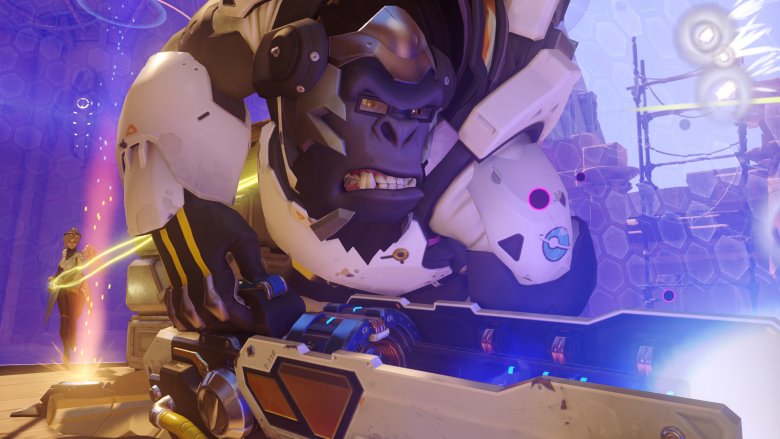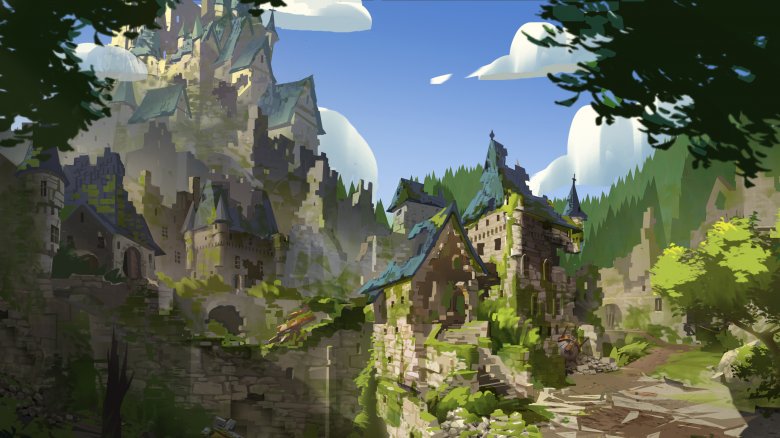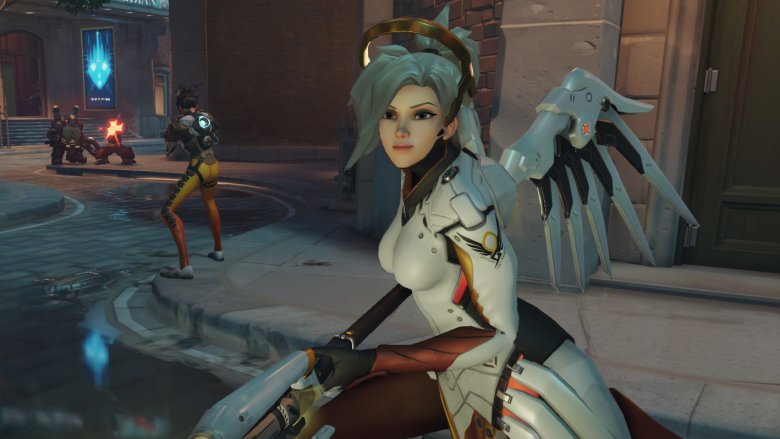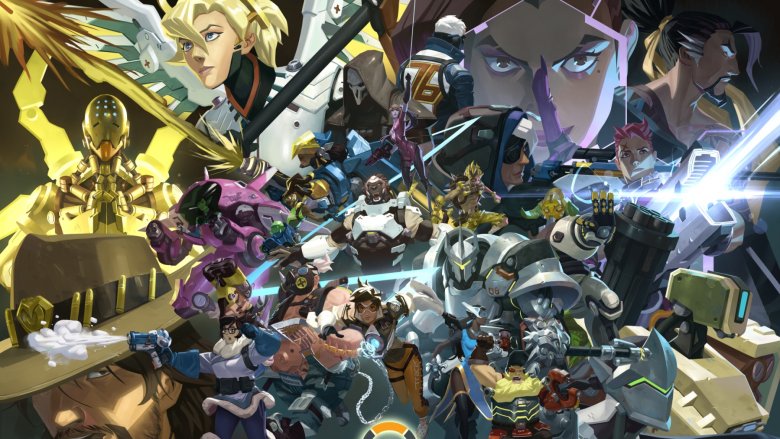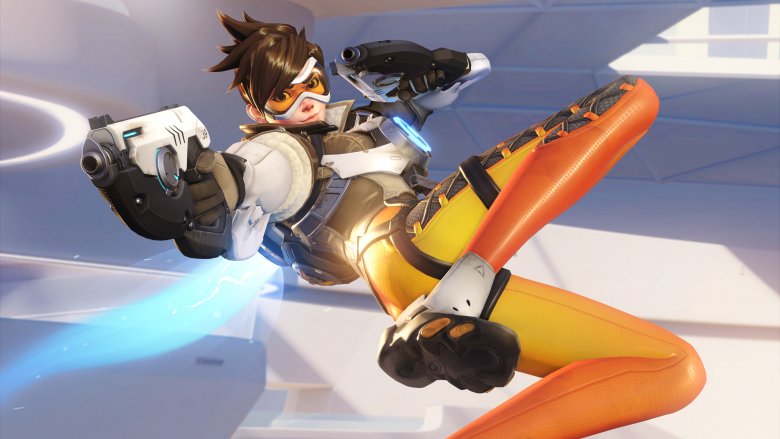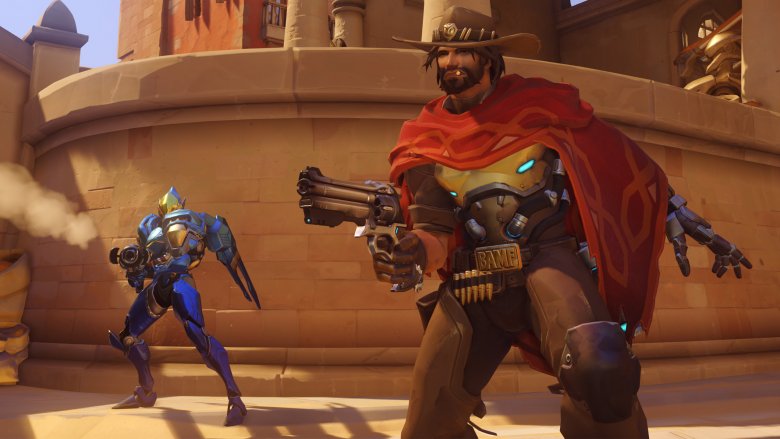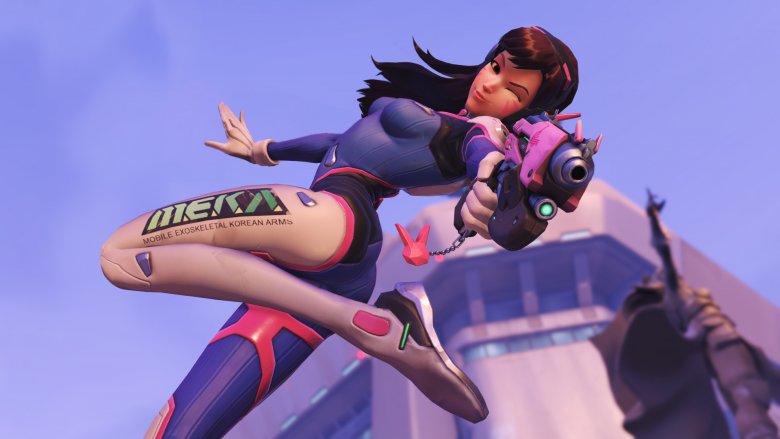The Untold Truth Of Overwatch
Blizzard Entertainment is one of the true juggernauts of the video game industry, a massive studio that continuously pumps out megahits that redefine their genre. The first Warcraft game, Orcs & Humans, helped usher in the real-time strategy craze of the '90s; Diablo invented the action-RPG style; and StarCraft turned video games from a pastime hobby to a professional athletic event. And that's not even mentioning World of Warcraft, one the biggest and most successful games ever released, a phenomenon that grew out of the gaming niche and into a pop cultural sensation. The most terrifying words in the gaming industry are, "Blizzard's making a game like ours."
But for all of that, Blizzard hadn't created a brand-new story universe since StarCraft in 1998. World of Warcraft, together with its expansions, was the only release from the company from 2004 until 2010. Even once the Irvine-based studio started pushing out new products again, they were sequels to older series. So it was with both surprise and joy that, in 2014, the world learned that a brand new Blizzard intellectual property was on the way: a vibrant, optimistic game called Overwatch. The studio was expanding its portfolio once again.
But as it turns out, the history of Overwatch goes back a lot farther than 2014. It is, in fact, the last vestige of a more ambitious, and ultimately failed, venture. And its impact on both the company and the industry is much larger than it might at first appear, and is still growing today.
Here's the whole story of a monkey from the Moon.
Overwatch was once something else entirely
World of Warcraft reset the bar for what video games could accomplish, both as cultural touchpoints and as profitable products. A massively multiplayer online (MMO) game with a subscription model, Blizzard saw revenue coming in every single month from millions of dedicated players from around the world. So as Blizzard saw it, there was only one thing to do: make an even bigger MMO.
The result was seven years of development hell, as one of the industry's great studios wrestled with its worst enemy: itself. Codenamed Titan, the project was intended to be a colossal achievement spanning multiple genres and appealing to a wide variety of gamers. As another MMO, it would be a persistent world with millions of players paying a subscription. The gameplay would consist of two parts: a daytime section that would model itself on the Sims series of games, in which players lived out a normal life with day jobs and friends; and a nighttime section where these ordinary characters would become heroes and accomplish missions together in a first-person shooter style.
If that sounds like a bite too big to swallow, that's because it was. After seven years of iteration, trial, and error, Blizzard was finally forced to throw in the towel. Any other studio would have simply released whatever they had on hand, but the Irvine team has always refused to release anything but solid gold.
Overwatch was resurrected like it had a Mercy on its team
Still, even with Titan being formally canceled, there was a lot of great work that had been done on the game. The nightime half, in which powerful heroes went on shooter-type missions, had been particularly fun to play. Blizzard had never dabbled in the popular first-person-shooter genre before, and Titan had been meant to be their entry into that format. So eventually, they asked the question: what if they salvaged the shooter portion of Titan and turned that into its own project?
Nobody wanted to go back to the development hell of Titan. So from the get-go, they decided the new shooter game would be a smaller project, and a much more focused one. It helped that a small team at Blizzard was working on a very small-scale game called Hearthstone, which wasn't a gigantic graphical powerhouse, but a simple card game. Hearthstone's fun, addictive gameplay in such a compact package helped the team realize that smaller titles could be just as good — and just as Blizzard — as World of Warcraft.
A brainstorming session finally got everybody lined up on a single direction: a multiplayer shooter game based not on classes that leveled up in a persistent fashion, but on heroes that would always be the same in every match, yet would all be distinct from each other. And at long last, the best elements of the failed Titan project could all come together in a package that didn't have to be the biggest and craziest game ever made. It could just be good. It could just be Overwatch.
Tracer blinked in first
According to game director Jeff Kaplan, the whole new project started to coalesce when one of Titan's classes became the individual character, Tracer. Titan had a Jumper class with very similar abilities to the spritely English girl we know now: Blink, Recall, and Pulse Bomb. But as a persistent class that would unlock new powers over time, the Jumper was also a very bloated design with a lot of different variations and combinations.
So in keeping with the new game's theme of simplicity, the Jumper class was the first one to be reworked into an individual hero with her own personality. Embodying the ethos of positivity, Tracer as a character was designed to be endlessly optimistic about everything, a sharp contrast to the grim darkness of most FPS games. Blizzard designed more and more heroes around her, until at last the new Overwatch project had a broad roster of memorable heroes for the player to choose from.
But Tracer clearly retains a special place in Blizzard's hearts: she's the mascot character on the box art for the game, and is now also the logo for the Overwatch League. She was right there in the original announcement trailer, and continues to be a top-tier character in both casual and professional play. If she hadn't been there to capture the developer's interest, we might never have gotten Overwatch at all. She saved Titan from itself. Now there's a hero.
Everybody assumed it would be a free-to-play game
After Overwatch was finally announced at BlizzCon 2014, people noticed a few qualities: it was multiplayer-only, and it was based on a diverse lineup of powerful heroes. That made it sound a whole lot like another game that had already displaced World of Warcraft as the most-played game in the world, and knocked off StarCraft from its eSports perch: Riot Games' MOBA League of Legends. And one of the hallmarks of the MOBA genre is its innovative business model, in which the game itself is free, but the heroes cost money for players to use consistently.
And so, everyone assumed that Overwatch would launch as a free-to-play game, very much in the MOBA vein. Even Overwatch's most direct parallel, Valve Software's Team Fortress 2, had switched from a paid to a free model. Blizzard itself had met success with that model with their Hearthstone card game, which had unexpectedly become a revenue windfall with only a small development budget. Why wouldn't Overwatch go the same way?
It turns out, for good reason: because Overwatch's gameplay depends on players constantly switching between all of the various heroes to evolve with matches' changing dynamics. If Blizzard had forced players to pay for every hero, then very few players would have every single one, and most wouldn't have very many at all. By going with a traditional paid model, it allowed every player to have every hero, all the time. And the game is better for it.
It was a Blizzard legend's final act (as a Blizzard legend, at least)
Chris Metzen was one of the old guard at Blizzard, one of the very first employees and the man who shepherded the lore and story for all Blizzard projects. A staple at fan events the world over, Metzen was in many ways the face of the company. Indeed, when Overwatch was at last revealed at BlizzCon 2014, it was Metzen himself who made the announcement.
And it was, in effect, his final act. Shortly after the game formally debuted, Metzen announced that he was retiring in a heartfelt letter to the Blizzard community. He would later say that the development of Titan and Overwatch had been very stressful for him, and after decades in the gaming industry, the time had simply come for him to leave it behind. But however tough that nearly decade-long development process was, he did stick it out until the end. Overwatch released to critical and commercial success, and the game's vibrant and bright worldview has charmed gamers the world over. What a note to go out on.
And he did, indeed, go out. Metzen made it clear that he was not pushed out of the studio, nor was he going to another company or setting up his own shop. He was retiring: spending time with his family and not worrying about the next project or working insane hours. His legacy remains as some of the greatest story universes in the entire medium: Warcraft, Diablo, StarCraft... and, of course, Overwatch.
Tracer breaks more barriers than just time
We've already mentioned how Tracer grew into the mascot of the whole franchise. She's a great face for the game: optimistic, cheerful, and capable of cutting holes through time. Plus, she's a really great hero to play as. But in Tracer's case, the space-time continuum isn't the greatest barrier she broke through.
In a webcomic, Blizzard revealed that Tracer is, in fact, a gay character. This is not central to the comic's storyline, nor was any major announcement ever made about this: it was just something that was shown in the middle of the comic. That's it. Just another aspect of the character, like the fact that she happened to be British. On the surface of it, this seems to be a minor detail. But it's not.
The very fact that Blizzard chose not to make a big fuss over the revelation speaks to the overall theme of the game: the world is diverse and inclusive, and people just are who they are, and it's normal that they are. Beyond that, there are very few gay characters across the gaming landscape, and exceedingly few who are main or mascot characters. Tracer, in this sense, represents a bold, daring risk for Blizzard. Except, the Irvine studio has never treated her that way. They just treat her as, you know, a person.
Which is the whole point.
The game was a smash even by Blizzard standards
When Blizzard finally launched Overwatch on May 24, 2016, they weren't entirely sure how it was going to go over. It wasn't the behemoth blockbuster multi-genre subscription-based MMO that Titan was intended to be. What it was, in the final analysis, was a multiplayer shooter with a handful of different modes and a broad roster of heroes. But there were no ability unlocks, and no progression system outside of skill rating. Every match would more or less be the same. Is this what people wanted? Would this succeed like Blizzard hits before it?
In a word: yes. In two words: very yes. By the end of 2017, Overwatch had sold over 35 million units, enough to put it in the top eschelons of all games ever made. Far from being a small-scale side-project, Overwatch has become one of the most talked-about shooters of the last five years, and as time has gone on, it's playerbase does not appear to have dipped a bit. Certainly, its sustained sales over time suggest a thriving community.
Shooter games come and go, but Blizzard has continued to support Overwatch by adding new content, at no additional charge, every few months. In stark contrast to the Call of Duty or Battlefield business model, Overwatch lives by the theory that once you pay for the game, you should get everything. Period. That level of support has kept lapsed players coming back, and long-term players happy. And the game doesn't seem to be slowing down in the least.
It has loot boxes that people don't hate (for now)
Loot boxes are the new buzzword for monetization in the gaming industry. Perhaps not surprisingly, they are also the most reviled trend in the community. Major releases such as Electronic Arts' Star Wars: Battlefront II have been met with a sea of controversy by angry gamers because of their inclusion. So what the heck are they?
A "loot box" is effectively a digital package that players can purchase in-game, usually with actual money, to get various items — and some of them may make your character more powerful. So if you've already paid full price for a game, the argument goes, why should you then have to pay more money to get the best items and equipment? It's a question that's still dividing the industry as of this writing.
Overwatch, meanwhile, uses loot boxes — but so far has managed to mostly avoid the wrath of gamers. The reason is simple: once you buy the game, you get all of the gameplay with no restrictions. Every mode, every map, every hero, every ability. Not just when you purchase the game, but as new gameplay content is released, you get that, too. There is nothing to stop anyone who bought Overwatch from playing Overwatch.
So what do the loot boxes actually contain? Just cosmetic items, such as alternate hero skins, emote animations, and spray tags. Fun stuff that people do want, and indeed, do pay for, but nothing that would impact the outcome of an actual match. Whether or not the general resentment against loot boxes will finally turn towards Overwatch remains to be seen. But for now, Overwatch is the gold standard by which other loot box systems are measured.
There's more to Overwatch than Overwatch
For all the work that Blizzard did to give each hero their own backstory and peronality, and to fill the world with a rich history and lore, very little of that made it into the final product. Overwatch is, at the end of the day, a simple multiplayer shooter. Start the match, pick your hero, and try not to die. While the heroes quip at each other, there's nothing like a conventional narrative.
But from the get-go, Overwatch as a franchise has been about more than just a single game. Blizzard has published a long list of webcomics, which feature everything from character pieces to major plot events. In a way, these comics represent Overwatch's lore better than the game itself ever has. Betrayals, alliances, friendships, and schemes have all played out in these panels, and there are clearly more to come.
As cool as the webcomics are, nothing has made as big a splash as the animated short videos that Blizzard releases every few months. Each one showcases a major event in the life of one or more characters, sometimes diving into the very moment when the character became a hero. Beautifully rendered, succinct yet profound, each one is a wonder to behold. Blizzard's animation department has always been the envy of the entire gaming industry: no other studio has an in-house cinematic team that's at anywhere near their level. Now, Blizzard is utilizing that advantage to the hilt. Overwatch isn't just the game: it's a whole media enterprise.
Overwatch League is a first for eSports
There have been a lot of games with an eSports scene over the years. Sometimes these games are run through small, independent events; other times, they're run through media companies that have season-long event lists. The teams themselves are independent entities that choose to enter one or more league events, and can often compete in multiple separate championships. Their only revenue comes from winning tournaments, or through outside sponsorships.
With the success of Overwatch, the world figured that an eSports scene would emerge around it. But Blizzard went the extra mile and decided to fold that process in-house and create its own studio-run Overwatch League, the first such venture of its kind. Unlike other leagues, not just any team can compete in the Overwatch League: a team must be vetted and approved by Blizzard before obtaining a license to play. And Blizzard owns the arena, sets the schedule, and runs every single event. This is much closer to established sports, like football or baseball, than the older eSports system.
With its first season just completed, Overwatch League has been a major, if uneven, success. The first week alone drew more than 10 million viewers. These numbers dipped a lot as the season progressed, but the Grand Finals were broadcast on TV as well as Twitch. The barrier between physical, traditional sports and eSports is beginning to crack.
Not bad for a game that started its life as a completely different game.

